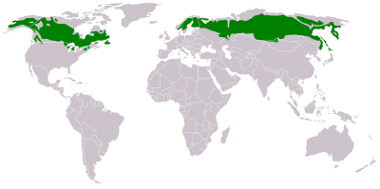THE taiga – also called Boreal Forest or even Coniferous Forest – is a type of vegetation present in some countries of the northern portion of the northern hemisphere, such as Canada, Russia and some other regions of Europe and Asia (see map bellow). It is a forest formation that is adapted to cold climate environments with little air humidity.

Distribution map of the original Taiga vegetation around the world *
The regions where Taiga is located, as we have already said, are very cold — the climate is the subarctic — and present icy and very strong winds. Winter is long, and temperatures can reach -54ºC. Summer, in turn, is short, and the temperature reaches, at most, 20ºC in a few occasions throughout the year. Rainfall, in the form of snow or rain, is rare and does not usually exceed 100 mm per year.
These temperature conditions, as well as the absence of nutrients in the soil, which is shallow and acidic, hinder the diversity of plant species. For this reason, we say that Taiga has a homogeneous vegetation, with very similar landscapes along its length (see the photo at the beginning of the text). The most common tree species are the conifers and the Pine trees, which appear in the form of "needles" or cones (aciculifoliate), in a strategy to not accumulate snow on their branches and retain moisture.
The fauna of Taiga presents itself with several species, with emphasis on the bears (mainly the bears brown bears), as well as bison, moose, wolves, foxes, hares, squirrels, bats and some types of birds. Some of these species migrate to other regions in times of more severe winter, others remain thanks to their adaptations, and some animals opt for hibernation.

Two brown bear cubs accompanied by their mother in a Taiga environment
Taiga, despite being a beautiful landscape in all its extension, could become extinct, as most of its reserves was deforested for human occupation and, mainly, for the production of paper and commercial use of its woods.
* Image credits: joonasl / Wikimedia Commons
By Me. Rodolfo Alves Pena


